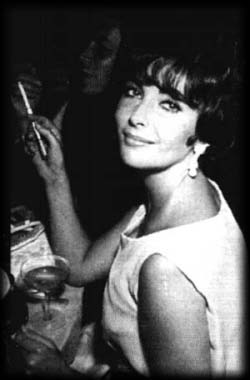As a child star whose chief charm was striking beauty, not cuteness or wistfulness, Taylor was trained early to glow for the camera, to sustain herself as a perfect image rather than as a particular character. As Helen Burns, the heroine's saintly little schoolfellow in "Jane Eyre," which she made (along with "National Velvet") in 1944, when she was 12, she lets her beauty do all the work: it produces the sweetness and saintliness and the pathos of her death all by itself. She became an un-self-conscious beautiful creature, acting the part in life and on screen. A luscious womanly ripeness, complete before she was 17, was added to the incandescent look she had at 12, and together they gave her an extremely traditional dark feminine beauty, unguarded, pure and strong, devoid of caprice or guile. Her figure was without sinew and apparently boneless in the classical manner. Taylor could be besotted (Cleopatra) or devoted (Rebecca in "Ivanhoe") or a doomed Southern belle (in "Raintree County"), because she herself seemed to be one of those mythical dark ladies who are all the same Dark Lady, ever since the Bible and ancient Greece: she who stands for imprudently excessive passion, or devotion, or fury, and who eventually loses out; the one who may well die or go mad or be otherwise sacrificed to a man's duty or ambition in favor of the reticent Blonde who will be his ultimate prize. As the 60's and her 30's were ending, she began to play the part of Fading Beauty, on film and in life; and she became much more interesting to her public. More hysteria and bitterness, more anxiety and desperation came to flavor the perfect face and body, and she began to gain weight. Her life and her roles became more baroque; she lost the weight and gained it back; she had well-publicized medical crises; she began to seem truly human, more like the fleshy brunettes of real life. A tinge of the victim, never absent from her Dark Lady image, was increased and gave zest to public perception of her now-threatened beauty. Leveled at her chin and waistline, her fans' gaze sharpened as they held their breath. Taylor's partial eclipse has come from the fact that her roles in life and art, so closely linked, have not been the most important recent ones for women. The Fatal Woman has come to the fore: the lethal villain played by Sharon Stone or Kathleen Turner or Glenn Close in the blond version, or by Demi Moore and other sulfurous new brunettes, all of them wised-up and heartless in very un-Taylor-like ways. The Grande Amoureuse is out of style, the woman like Cleopatra who risks all for love. So is the straightforward adventuress like Gloria in "Butterfield 8." Present-day adventuresses have their own ambitions and don't make careers out of liaisons or marriages. Taylor has rarely played somebody with professional work to do. She's been Wife, Daughter, Mistress, Mother, Siren, Queen - and she's done no housework either. Her sculptural body could never seem at home with the vigorous distortions required by active work, even in show biz. She couldn't play a singer or a dancer. Taylor has appeared on the stage, perhaps to prove she's a real actress; but the theater, where illusion is paramount, is no place for this mythic creature who, in the purest cinematic tradition, has always played herself. ANNE HOLLANDER is the author of "Sex and Suits." (this article courtesy of The New York Times Magazine) |
 She has lately stepped gracefully down
a few notches from her pinnacle, but her image is indelible, and she has earned the right
to a certain voluntary eclipse. Now in her middle 60's, an age at which Marlene Dietrich
was still appearing nightly in sequins and feathers, mesmerizing live audiences in Las
Vegas, Elizabeth Taylor is a select apparition, visible only here and there.
She has lately stepped gracefully down
a few notches from her pinnacle, but her image is indelible, and she has earned the right
to a certain voluntary eclipse. Now in her middle 60's, an age at which Marlene Dietrich
was still appearing nightly in sequins and feathers, mesmerizing live audiences in Las
Vegas, Elizabeth Taylor is a select apparition, visible only here and there.